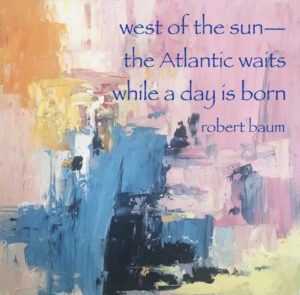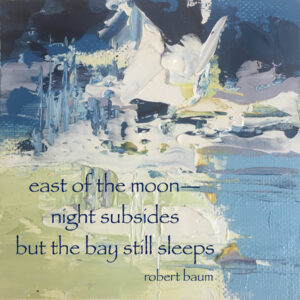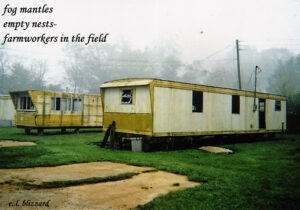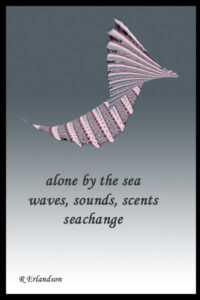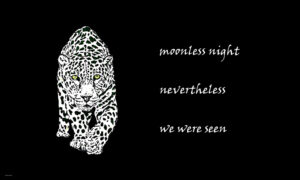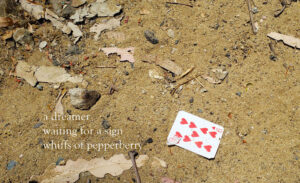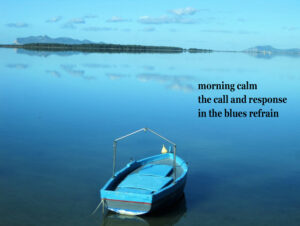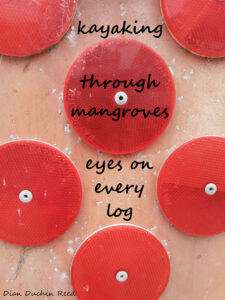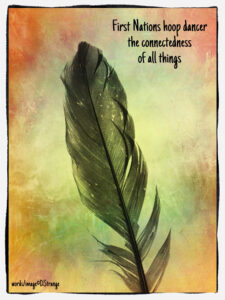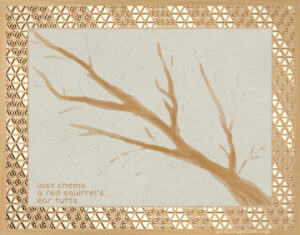Haiga Gallery 17.1
This month’s Haiga Gallery once again presents a wide range of the styles and approaches used by modern haiga artists. In these works, you will see the traditional values of link-and-shift at play, as haiku, senryu, and tanka connect with a variety of media, from photographs and software renderings to hand-drawn and painted artworks. I hope you enjoy each poet/artist’s work as much as I do.
Ron Moss, Haiga Editor
About the Artists
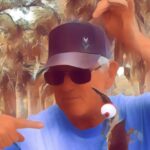
Robert Baum is a retired educator, writer/editor, and artist. “My wife and I spend half the year at the Jersey shore and the other half on the Gulf Coast of Florida. You can guess which half is which.”
From the Artist: “West of the Sun” and “East of the Moon” grew from decades spent on the Jersey barrier islands. I am pushing my art more and more abstract, inviting viewers to identify with the universal appeal of these images and messages.

E. L. Blizzard lives in the U.S. South with work in The Other Bunny, Drifting Sands, Bones, Wales Haiku Journal, Failed Haiku, #FemkuMag, Poetry Pea, Autumn Moon, Under the Basho, and others. She’s worked in advocacy, allying with immigrants/refugees, cis/LGBTQ+ survivors of intimate partner violence, and those experiencing homelessness.
From the Artist: Much of my photography and writing touch on social issues, mixing nature with humanity. My background includes studying cultural anthropology, training in participant-observation, and working in advocacy. This is reflected in any creative process I approach. I find the process of creating haiga a way to notice what can often be overlooked.
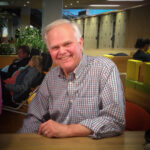
Robert Erlandson has published his haibun, haiku, tanka and haiga in Haigaonline, Daily Haiga, Prune Juice, Cattails, Ribbons, and contemporary haibun online. He has also published AWE, a chapbook of poetry and images speaking to the incredible relationships between nature, art, and mathematics. See more at https://www.circlepublications.net/.
From the Artist: I create images from photography, drawing and painting, both digitally and the old-fashioned way with pencil and brushes. Most recently I have started to create digital art using fractal images. While there is no formula for my creation of haiga, there is definitely a creative rush as an image and words associate. Sometimes the ideas come as words or phrases that I can associate with an existing image. Or an image evokes an emotional response with words following. The subject matter depends on what’s running around in my head at some point in time.

cho haibun co-editor Terri L. French is a poet/writer, retired massage therapist and barista. The former editor of Prune Juice: Journal of Senryu & Kyoka, she has also served as the Southeast Coordinator of the Haiku Society of America and as Secretary for The Haiku Foundation, of which she is currently a board member.
From the Artist: Usually in developing my haiga I start with an image, most often a photograph. I immerse myself in the photo to see what thoughts, emotions and memories may arise and what senses are stimulated. Then I will write several haiku to find the best fit. I want the image and poem to complement rather than overshadow each other. Occasionally I will employ the novice artist in me to create an image—using pen, paintbrush or computer-aided design. I also find it very satisfying to work with other poets/photographers/artists in creating a haiga.
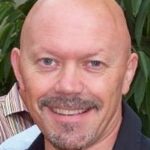
John Hawkhead has been writing haiku and producing haiga for over 20 years, with work published all over the world. Apart from cho, you can see his haiga at Daily Haiga, Modern Haiga, Wales Haiku Journal, Human/Kind, and many other publications
From the Artist: Haiga can start from the haiku or the image, so there isn’t one route into a finished work, but I particularly like using ink & paint drawings alongside the written word. Finding the right words to best match an image is, however, not as easy as I’d like…
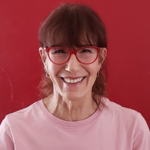
Vicki Miko is a retired television producer, a published illustrator/photographer, and now, happy to be among published haiku poets. Vicki was introduced to haiku in a meditation class. For her, haiku is mindfulness. Poetry inspiration comes from her patient, humoring husband, plus, living and hiking in California. Her website is http:/www.vickimiko.com.
From the Artist: I am inspired by the haiku community and all that it offers to its newcomers! I’m starting to match up my forever accumulating haiku notes with my photos and art, and vice versa. Haiga seems to be like a three-layered poem: an observance, tweaked by memory or idea, all together expanded by an image. I like that!
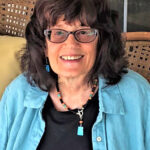
Joan Prefontaine is a teacher, writer, art lover and photographer. Her poems, haiku, haibun and haiga have been published in many journals and anthologies. She teaches classes on Southwestern Art and other topics for Osher Lifelong Learning Institute in the Verde Valley of Arizona.
From the Artist: I enjoy combining haiku with photos from my travels and from my explorations of the American Southwest. I like hiking and birdwatching and always have a camera with me, as I wait for the right light and moment to appear.
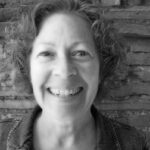
Dian Duchin Reed is an award-winning writer whose poems, articles, essays, and photographs have appeared in many publications. Her books include Medusa Discovers Styling Gel (poetry) and Dao De Jing: Laozi’s Ancient Wisdom (translated from the Chinese). Learn more at dianduchinreed.com
From the Artist: Creating haiga has changed the way I take photos. There’s always space to place a haiku, although the layout differs from picture to picture. I suppose it’s also changed the way I look at the world, paying more attention to whatever evokes an emotional response, staying with it a little longer, listening for what it wants to tell me.

Debbie Strange is an internationally published short-form poet, haiga artist, and photographer whose creative passions connect her more closely to the world and to herself. She is honored to be the recipient of the 2020 Snapshot Press Book Award. Please visit her publication archive at debbiemstrange.blogspot.com.
From the Artist: My daily practice of creating art in a variety of media helps to distract me from chronic illness. I enjoy the meditative aspect of making haiga, and the challenge of pairing words with images in innovative ways.

